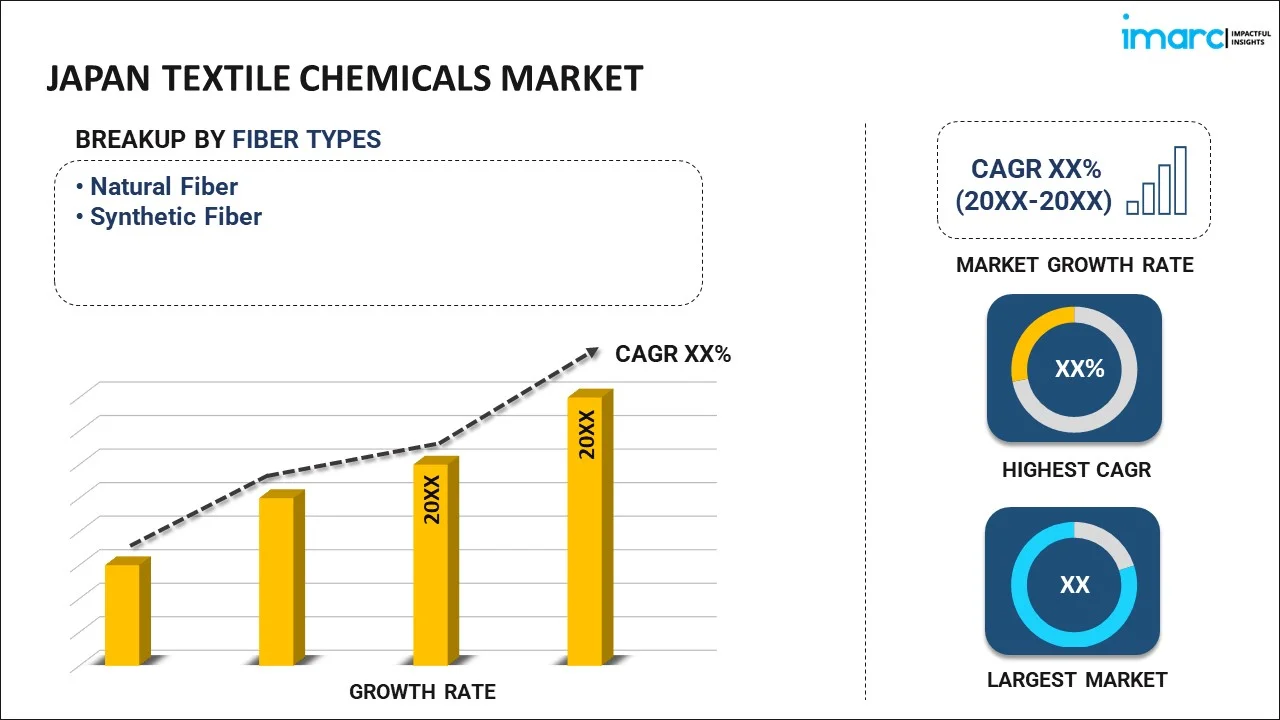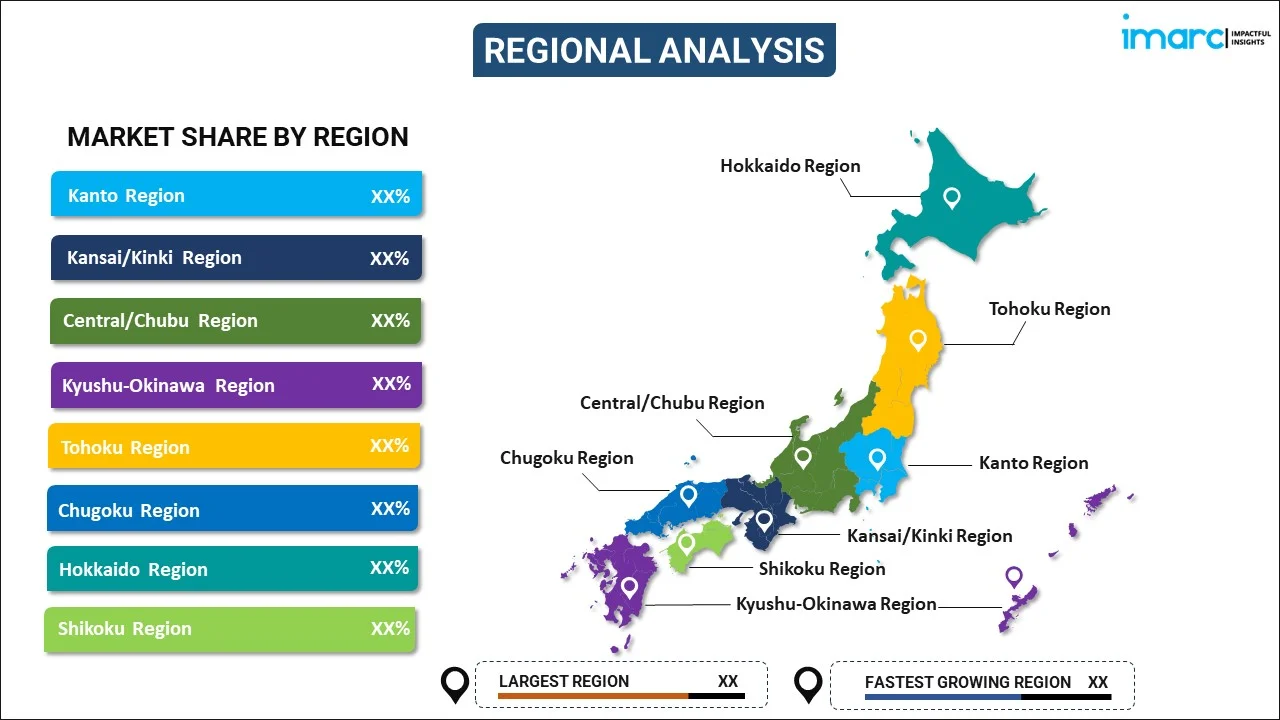
Japan Textile Chemicals Market Report by Fiber Type (Natural Fiber, Synthetic Fiber), Product Type (Coating and Sizing Chemicals, Finishing Agents, Colorants and Auxiliaries, Surfactants, Desizing Agents, and Others), Application (Home Furnishing, Apparels, Industrial Textile, Automotive Textile, and Others), and Region 2026-2034
Market Overview:
Japan textile chemicals market size reached USD 1.2 Billion in 2025. Looking forward, IMARC Group expects the market to reach USD 2.3 Billion by 2034, exhibiting a growth rate (CAGR) of 7.13% during 2026-2034. The market is being propelled by several key factors, including a growing desire for fashionable clothing featuring trendy designs and patterns, an increasing preference for durable and distinctive luxury brand garments, and the widespread adoption of influencer marketing through social media by textile and apparel firms.
|
Report Attribute
|
Key Statistics
|
|---|---|
|
Base Year
|
2025 |
|
Forecast Years
|
2026-2034
|
|
Historical Years
|
2020-2025
|
| Market Size in 2025 | USD 1.2 Billion |
| Market Forecast in 2034 | USD 2.3 Billion |
| Market Growth Rate (2026-2034) | 7.13% |
Textile chemicals encompass a diverse range of specialized chemical compounds that find application in the various stages of fabric processing, including pretreatment, dyeing, and finishing. This category includes a wide array of chemical agents, such as wetting agents, detergents, emulsifiers, sizing agents, desizing agents, dye carriers, dye leveling agents, dye fixatives, and additives for enhancing rubbing fastness. Textile chemicals also feature water-repellent substances like fluorocarbons (PFAS), synthetic waxes, and silicones. They play a pivotal role in processes like scouring, bleaching, and printing, enhancing the overall quality and appearance of textiles. Additionally, these chemicals contribute to the flame resistance, wrinkle resistance, stain resistance, and crease resistance of fabrics while preserving the integrity of prints and patterns. Moreover, they introduce antimicrobial properties to textiles, extending their lifespan, preventing odors, and reducing the likelihood of skin irritations. Optical brightening agents (OBAs) are also utilized to provide textiles with a pristine white appearance, serving as a canvas for vibrant prints and patterns.
Japan Textile Chemicals Market Trends:
Currently, the Japan textile chemicals market is witnessing significant growth due to the surging demand for clothing featuring trendy designs and prints. This trend has gained momentum, driven by the influence of social media influencer marketing campaigns launched by textile and apparel companies. Furthermore, the fashion industry is experiencing rapid shifts in trends, influenced by celebrities and the proliferation of fast fashion brands offering stylish attire at accessible prices. Simultaneously, there is a notable rise in consumers opting for durable and distinctive luxury brand clothing, including products from foreign textile companies. The market is also witnessing a preference for clean and sustainable bio-based textile chemicals that are non-toxic and environmentally friendly. These chemicals do not accumulate in the ecosystem, aligning with the increasing focus on sustainability. Additionally, the application of textile chemicals in the production of automobile fabrics like seat belts, seat covers, and headliners is contributing to market growth. Likewise, the demand for textile chemicals is expanding in the home decor segment, encompassing items such as curtains, carpets, bed linens, pillow covers, and sofa fabrics. These factors collectively contribute to the growing adoption of textile chemicals in Japan.
Japan Textile Chemicals Market Segmentation:
IMARC Group provides an analysis of the key trends in each segment of the market, along with forecasts at the country level for 2026-2034. Our report has categorized the market based on fiber type, product type, and application.
Fiber Type Insights:

- Natural Fiber
- Synthetic Fiber
The report has provided a detailed breakup and analysis of the market based on the fiber type. This includes natural fiber and synthetic fiber.
Product Type Insights:
- Coating and Sizing Chemicals
- Finishing Agents
- Colorants and Auxiliaries
- Surfactants
- Desizing Agents
- Others
A detailed breakup and analysis of the market based on the product type have also been provided in the report. This includes coating and sizing chemicals, finishing agents, colorants and auxiliaries, surfactants, desizing agents, and others.
Application Insights:
- Home Furnishing
- Apparels
- Industrial Textile
- Automotive Textile
- Others
The report has provided a detailed breakup and analysis of the market based on the application. This includes home furnishing, apparels, industrial textile, automotive textile, and others.
Regional Insights:

- Kanto Region
- Kansai/Kinki Region
- Central/ Chubu Region
- Kyushu-Okinawa Region
- Tohoku Region
- Chugoku Region
- Hokkaido Region
- Shikoku Region
The report has also provided a comprehensive analysis of all the major regional markets, which include Kanto Region, Kansai/Kinki Region, Central/ Chubu Region, Kyushu-Okinawa Region, Tohoku Region, Chugoku Region, Hokkaido Region, and Shikoku Region.
Competitive Landscape:
The market research report has also provided a comprehensive analysis of the competitive landscape in the market. Competitive analysis such as market structure, key player positioning, top winning strategies, competitive dashboard, and company evaluation quadrant has been covered in the report. Also, detailed profiles of all major companies have been provided.
Japan Textile Chemicals Market Report Coverage:
| Report Features | Details |
|---|---|
| Base Year of the Analysis | 2025 |
| Historical Period | 2020-2025 |
| Forecast Period | 2026-2034 |
| Units | Billion USD |
| Scope of the Report | Exploration of Historical Trends and Market Outlook, Industry Catalysts and Challenges, Segment-Wise Historical and Future Market Assessment:
|
| Fiber Types Covered | Natural Fiber, Synthetic Fiber |
| Product Types Covered | Coating and Sizing Chemicals, Finishing Agents, Colorants and Auxiliaries, Surfactants, Desizing Agents, Others |
| Applications Covered | Home Furnishing, Apparels, Industrial Textile, Automotive Textile, Others |
| Regions Covered | Kanto Region, Kansai/Kinki Region, Central/ Chubu Region, Kyushu-Okinawa Region, Tohoku Region, Chugoku Region, Hokkaido Region, Shikoku Region |
| Customization Scope | 10% Free Customization |
| Post-Sale Analyst Support | 10-12 Weeks |
| Delivery Format | PDF and Excel through Email (We can also provide the editable version of the report in PPT/Word format on special request) |
Key Questions Answered in This Report:
- How has the Japan textile chemicals market performed so far and how will it perform in the coming years?
- What has been the impact of COVID-19 on the Japan textile chemicals market?
- What is the breakup of the Japan textile chemicals market on the basis of fiber type?
- What is the breakup of the Japan textile chemicals market on the basis of product type?
- What is the breakup of the Japan textile chemicals market on the basis of application?
- What are the various stages in the value chain of the Japan textile chemicals market?
- What are the key driving factors and challenges in the Japan textile chemicals?
- What is the structure of the Japan textile chemicals market and who are the key players?
- What is the degree of competition in the Japan textile chemicals market?
Key Benefits for Stakeholders:
- IMARC’s industry report offers a comprehensive quantitative analysis of various market segments, historical and current market trends, market forecasts, and dynamics of the Japan textile chemicals market from 2020-2034.
- The research report provides the latest information on the market drivers, challenges, and opportunities in the Japan textile chemicals market.
- Porter's five forces analysis assist stakeholders in assessing the impact of new entrants, competitive rivalry, supplier power, buyer power, and the threat of substitution. It helps stakeholders to analyze the level of competition within the Japan textile chemicals industry and its attractiveness.
- Competitive landscape allows stakeholders to understand their competitive environment and provides an insight into the current positions of key players in the market.
Need more help?
- Speak to our experienced analysts for insights on the current market scenarios.
- Include additional segments and countries to customize the report as per your requirement.
- Gain an unparalleled competitive advantage in your domain by understanding how to utilize the report and positively impacting your operations and revenue.
- For further assistance, please connect with our analysts.
 Request Customization
Request Customization
 Speak to an Analyst
Speak to an Analyst
 Request Brochure
Request Brochure
 Inquire Before Buying
Inquire Before Buying




.webp)




.webp)












